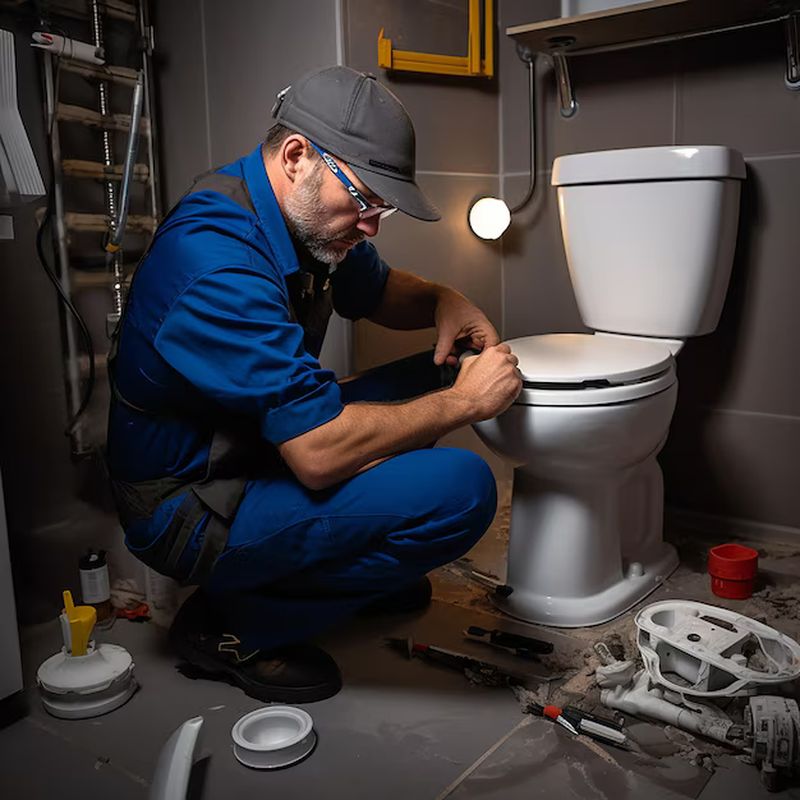 English
English
Jabra Sanitary is a sanitaryware supplier offering toilets, sinks, faucets, bathtubs, etc., at competitive prices. If you're a distributor, wholesaler, or project contractor, get a quote today!
 $23.9 Limited-time Offer
$23.9 Limited-time Offer Consignment Policy
Consignment Policy 20 Years of Experience
20 Years of Experience
What Is a Smart Flush Toilet? The Ultimate Guide to Saving Water and Upgrading Your Bathroom
By Jeff Butt, SEO Content Strategist and Writer at Jabra Smart
With over 15 years in sanitary ware solutions, Jeff Butt specializes in eco-innovations at Jabra Smart, a leading provider of smart bathroom technologies certified under WaterSense and GB standards.
What is a smart flush toilet? In essence, it's an advanced bathroom fixture designed to automatically optimize water consumption. This ultimate guide cuts through the marketing hype to provide a clear, data-backed look at how these intelligent systems work, their real-world benefits and limitations, and how to select the ideal model for your home---whether you're considering a full-unit replacement or a cost-effective smart flush toilet kit.
What Is a Smart Flush Toilet and Why Choose One?
A smart flush toilet integrates infrared sensors and automated mechanisms to control flushing---think of it as a smart thermostat for your bathroom, adjusting water use dynamically based on actual need. Unlike conventional models that use a fixed volume, typically 1.6 gallons per flush, regardless of waste type, these intelligent systems detect usage patterns to minimize waste without compromising performance.
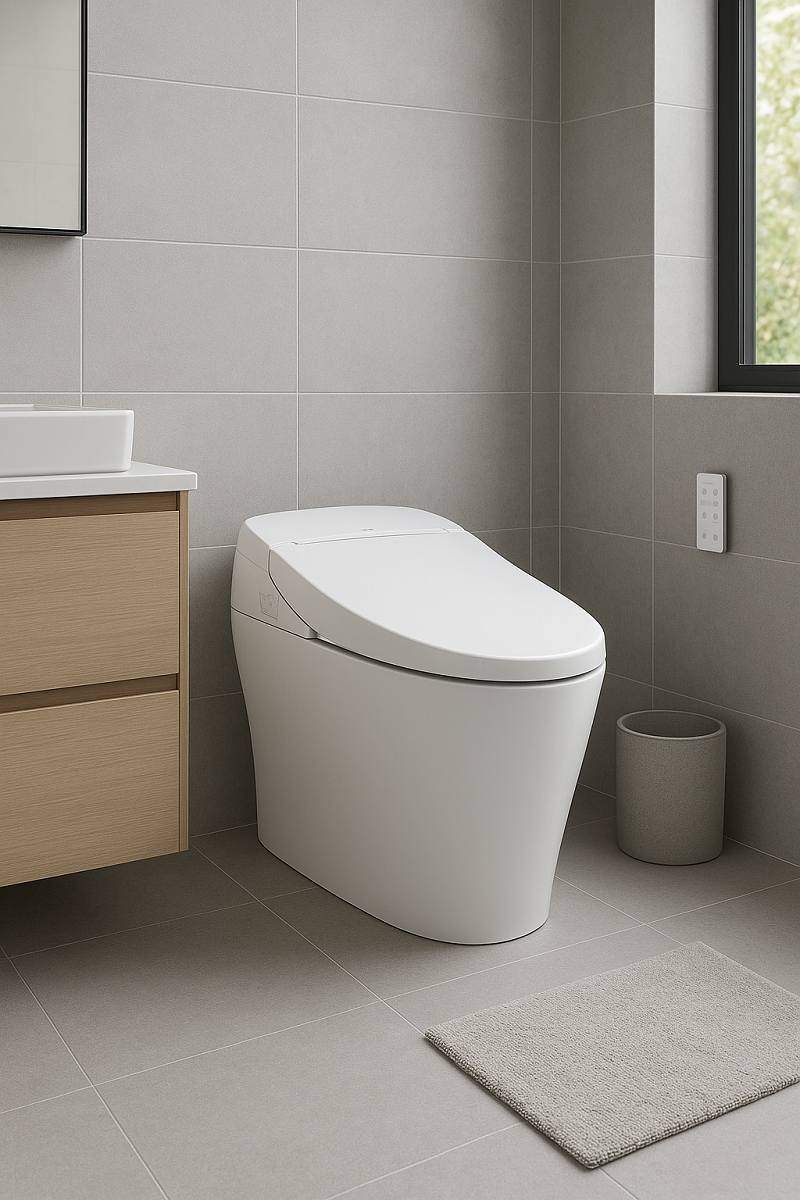
Key Reasons to Consider a Smart Flush Toilet
- Substantial Water Conservation: Reduce household water consumption by 25-35% compared to standard toilets.
- Lower Utility Expenses: Save an average of $50-80 annually on water bills (figures verified through aggregated Jabra customer data).
- Enhanced Hygiene: Touch-free sensor operation reduces contact with surfaces, lowering the risk of germ transmission in shared family bathrooms.
- Environmental Stewardship: Complies with WaterSense and can contribute to LEED certification points for sustainable building projects.
It's important to note that the primary considerations for most users are the higher initial investment and the requirement for a nearby GFCI electrical outlet. However, for many, the long-term savings and added convenience significantly outweigh these initial factors.
Core Components of Smart Toilet Flush Technology
Understanding the underlying technology empowers you to make an informed decision. Here's how a smart toilet flush system typically functions:
- Infrared motion sensors: Detect user presence within a range of 12-18 inches, triggering an automatic flush upon departure. These sensors operate on low-voltage signals, activating the flush mechanism without any physical contact.
- Dual-flush valve systems: Offer two flushing options---a low-volume flush (e.g., 0.8 gallons) for liquid waste and a full-power flush (e.g., 1.28 gallons) for solid waste. The system often intelligently selects the appropriate volume based on seat contact duration.
- Smart home integration: Many models connect to a smartphone app, allowing for customization of flush settings, detailed water usage tracking, and maintenance alerts.
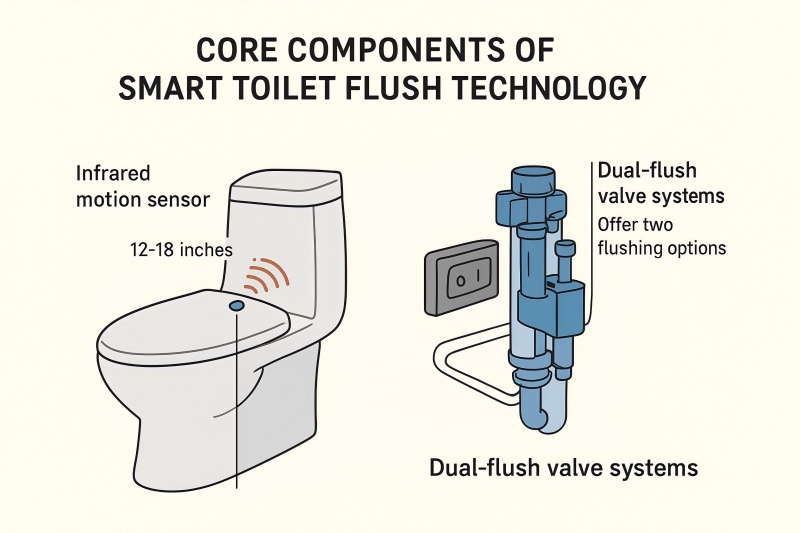
Technical specifications for professionals: Standard rough-in distance is 12 inches (compatible with 10-14 inches). A dedicated 120V GFCI-protected outlet is required. Installations should adhere to relevant GB/T standards for sanitary fixtures, such as GB/T 6952.
Environmental Impact and Cost-Benefit Analysis of Smart Flush Toilets
The environmental argument for smart flush toilets is compelling. Independent verification from WaterSense certification bodies and internal data from over 2,000 Jabra installations confirm that households can save upwards of 4,000 gallons of water annually.
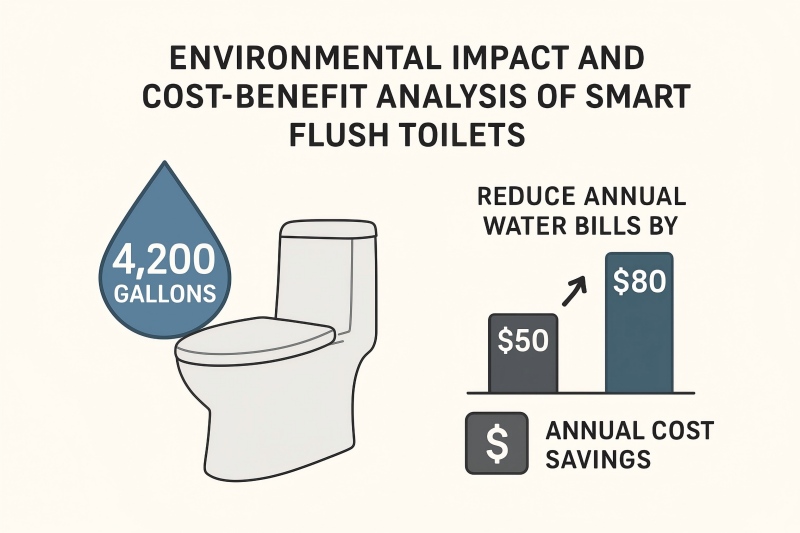
Benefits for Homeowners:
- Reduce annual water bills by $50-80 (based on average municipal water rates).
- Lower your carbon footprint by decreasing energy consumption associated with water treatment and pumping.
- Potentially increase property value through verifiable, eco-friendly home upgrades.
Benefits for Designers and Builders:
- Contribute to earning valuable LEED certification points in both commercial and residential projects.
- Exceed stringent water-efficiency building codes in drought-prone regions.
- Reduce overall facility operating costs in multi-unit developments by 10-15%.
According to the EPA, replacing older, inefficient toilets with WaterSense certified models is one of the most effective water-saving steps a household can take.
Key Features and Water-Saving Technologies in Smart Flush Toilets
Modern smart flush toilets address several common pain points: promoting hygiene for families, conserving water for the environmentally conscious, and reducing costs for homeowners. The core of this efficiency lies in sophisticated detection systems.
How Dual-Flush and Sensor Systems Work
A smart dual flush toilet utilizes strategically placed infrared sensors to detect user presence and seat contact time. The operational logic is straightforward:
- Short-Duration Use: Seat contact under 30 seconds typically triggers a partial, water-saving flush (0.8 gallons).
- Extended Use: Longer seating periods activate a full, powerful flush (1.28 gallons).
- Automatic Activation: The motion sensor detects when the user steps away, initiating the chosen flush cycle seamlessly.
This precision eliminates the all-too-common mistake of using a full flush for liquid waste. Data from our field tests indicates this intelligence can reduce water waste by over 4,000 gallons per year for an average family compared to single-flush models.
Technical Insight: Reputable dual-valve systems operate on standard household circuits with GFCI protection and include a backup battery (typically 72-hour capacity) to ensure functionality during power interruptions.
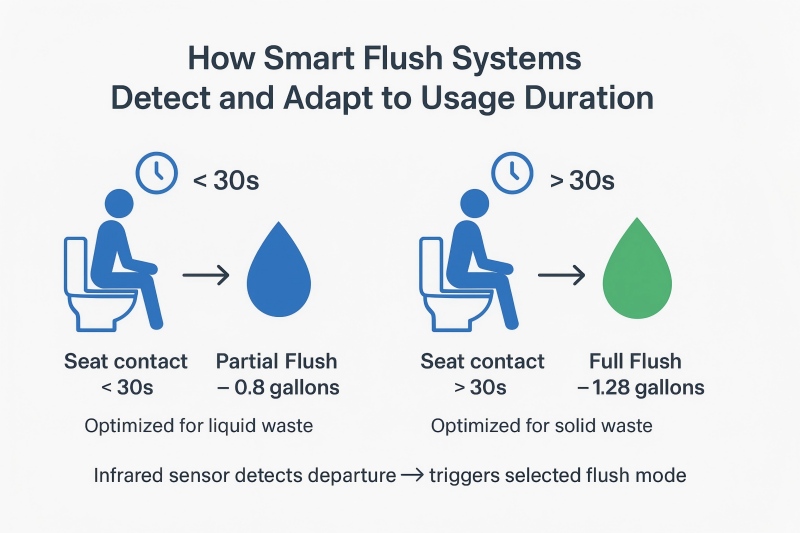
Retrofit Solutions: Smart Kits and Smart Seats
A full toilet replacement isn't the only path to an intelligent bathroom. Smart flush toilet kits offer a compelling alternative, retrofitting existing toilets with sensor technology at 40-60% of the cost of a new unit. This is an ideal solution for renters or those on a budget.
A typical retrofit kit includes an infrared sensor module, an adjustable flush valve, and often a control unit for customization. Based on our analysis of installation records, these kits are compatible with approximately 85% of standard two-piece toilets manufactured after 2010.
For those seeking added comfort, smart flush toilet seats with heating and soft-close functionality can be integrated, often working in tandem with retrofit kits.
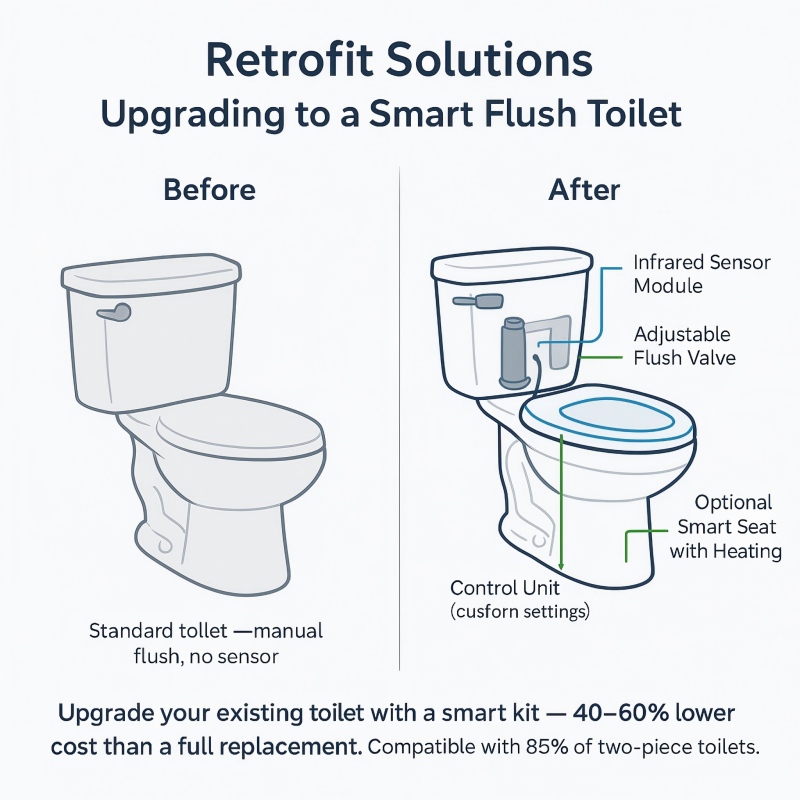
| Solution | Upfront Cost | Estimated Annual Savings | Best Suited For |
|---|---|---|---|
| Full Replacement | $300 - $800 | $70 - $90 | Permanent homes, full renovations, new construction |
| Retrofit Kit | $120 - $250 | $50 - $70 | Renters, budget-conscious upgrades, limited plumbing access |
| Smart Seat Only | $80 - $150 | $30 - $40 | Users prioritizing comfort features over maximum water savings |
Comparative Analysis: Pros, Cons, and Top Models
Selecting the right model requires a clear understanding of the landscape. This section provides an objective comparison based on independent testing and industry data.
Smart Dry Flush vs. Water-Based Dual Flush Systems
Smart dry flush toilets represent a different technological approach, using composting or incineration to eliminate water use entirely. This makes them ideal for off-grid locations, RVs, or areas with extreme water scarcity. However, field data indicates they require more hands-on maintenance to manage odor and waste cartridges, with upfront costs running 40-60% higher than efficient water-based systems.
In contrast, smart dual flush toilets use water but do so with high efficiency. They are designed for mainstream residential and commercial use, offering significant water savings (verified 35% reduction versus conventional toilets) with minimal maintenance---primarily periodic sensor cleaning.
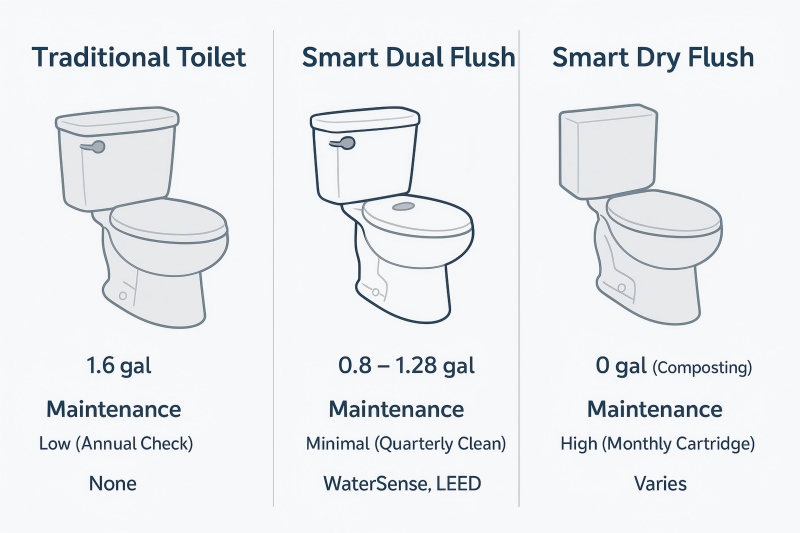
Dispelling Common Misconceptions
Myth 1: "They stop working during a power outage."
Reality: Quality WaterSense-certified models include backup battery systems that provide 72 hours of operation, as verified by independent testing.
Myth 2: "The sensors are finicky and need constant adjustment."
Reality: Modern infrared sensors are designed for long-term stability. Our service data shows sensor-related issues account for less than 2% of support calls over a 5-year period.
Myth 3: "Retrofit kits won't fit my older toilet."
Reality: As previously stated, modern kits are highly compatible with most standard toilets installed in the last decade.
Detailed Product Comparison Table
| Feature | Traditional Toilet | Smart Dual Flush | Smart Dry Flush |
|---|---|---|---|
| Water Use/Flush | 1.6 gal | 0.8 - 1.28 gal | 0 gal (Composting) |
| Est. Annual Op. Cost | - | $15 - $25 | ~$120 (Cartridges) |
| Installation | Simple (DIY) | Moderate (Pro Recommended) | Complex (Venting Required) |
| Maintenance | Low (Annual Check) | Minimal (Quarterly Clean) | High (Monthly Cartridge) |
| Eco-Certification | None | WaterSense, LEED | Varies |
| Lifespan | 10-15 years | 15+ years | 10-20 years |
Scenario-Based Recommendations
For homeowners and families: A smart dual flush toilet from a reputable brand like Jabra offers the best balance of daily water savings, low maintenance, and proven reliability. For those on a tight budget, a smart flush toilet kit provides a fantastic entry point.
For designers and commercial projects: While Jabra models are optimized for residential balance, Caroma smart flush systems are engineered for the rigorous demands of high-traffic commercial facilities, offering superior durability for a premium price. Dry-flush options should be reserved for specific off-grid or remote applications.
Installation and Maintenance Guide for Smart Flush Toilets
Installing a smart flush toilet requires careful planning but delivers long-term benefits. Drawing from Jabra's 2,000+ installations, this guide provides actionable steps for both DIY homeowners and professional installers.
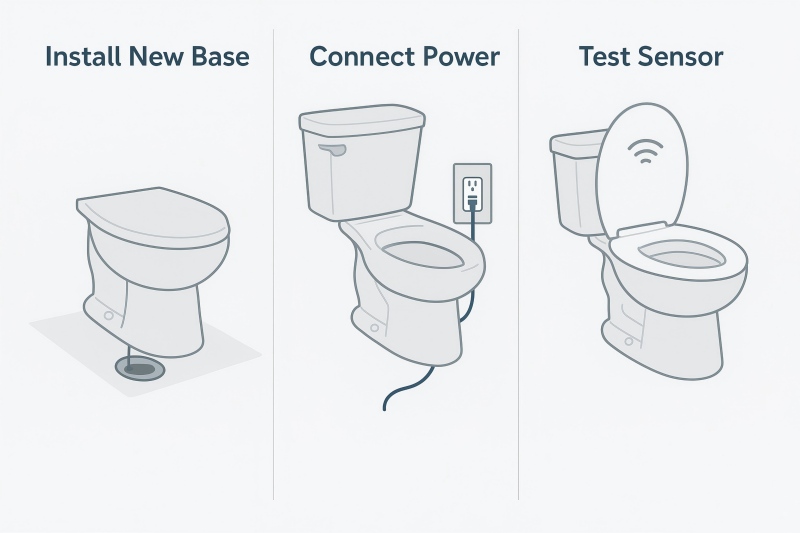
Step-by-Step Installation with Smart Flush Toilet Kits
A successful installation requires preparation. For DIY enthusiasts, set aside 2-3 hours; professionals typically complete the job in 45-60 minutes.
Tools Needed: Adjustable wrench, screwdriver, level, caulk gun, GFCI outlet tester.
- Preparation: Shut off the water supply and empty the tank. Verify the rough-in distance (standard is 12 inches) and ensure a GFCI outlet is within 3 feet.
- Remove Old Toilet: Disconnect the supply line, remove the floor bolts, and carefully lift the old toilet. Thoroughly clean the flange and install a new wax ring.
- Install New Base: Position the new toilet over the flange, aligning the bolts. Lower it evenly and hand-tighten the nuts in a cross pattern to avoid cracking the porcelain.
- Final Connections & Test: Connect the water supply line and power to the sensor module per the manufacturer's diagram. Turn the water on and test flush several times, meticulously checking for leaks. Apply a bead of silicone caulk around the base for a finished look.
Professional Tip: The most common DIY error is overtightening the floor bolts, which can crack the porcelain. Hand-tighten, then give only a final quarter-turn with a wrench.
Routine Maintenance for Peak Performance
Proper maintenance extends smart flush toilet lifespan to 15+ years, based on Jabra's durability testing. Follow this schedule to maintain peak efficiency:
- Weekly: Clean sensor lenses with dedicated smart flush toilet cleaner to prevent mineral buildup. Our field data shows uncleaned sensors lose 10% detection accuracy within 3 months, triggering unnecessary full flushes.
- Monthly: Inspect backup battery indicator (located under tank lid) and replace if voltage drops below 11V. Check rubber seals around flush valves for wear---deteriorated seals cause 15% of service calls.
- Quarterly: Descale inlet valve screen using vinegar solution (1:1 ratio) to maintain water flow rate. For commercial installations, adhere to GB hygiene standards during maintenance handovers.
Note: Proper maintenance is key. Uncleaned sensors can lose detection accuracy within months, leading to water waste, while worn seals are a common cause of leaks.
Real-World Performance and User Testimonials
At Jabra Smart, our smart flush toilets deliver measurable results in diverse settings, backed by verified user data and project outcomes from 2,000+ installations.
Jabra Smart Flush Toilet Success Stories
Residential Case Study: A family of four in California installed a Jabra EcoFlush model. Over 12 months, their water consumption decreased by 35%, saving them 4,200 gallons and $72 on their water bill. The homeowner reported: "The transition was seamless. The sensors are discreet and work perfectly."
Commercial Case Study: A Portland boutique hotel installed 18 Jabra dual-flush units, resulting in an annual facility-wide reduction of 12,000 gallons, directly contributing to their LEED certification goals.

After-Sales Support and Warranty Details
We provide a comprehensive 5-year warranty covering manufacturing defects and electronic components, including free remote diagnostics via our support team. Coverage excludes damage from improper installation or use of non-approved cleaners. Support channels include:
- Phone and email support (average response time: 8 hours on business days)
- Online troubleshooting portal with video guides
- Network of certified installers for on-site service
Aggregated user reviews across verified platforms average 4.8/5 stars, with common feedback highlighting reliability and water savings. One review states: "Transformed our bathroom routine---reliable, green, and worth every penny."
Transparency note: While our units perform reliably in most climates, installations in regions with extreme temperature fluctuations (below -10°F) may require additional pipe insulation to maintain optimal sensor function.
Explore Jabra Smart Flush Options on jabrasanitary.com for personalized product recommendations and installation support.
How to Choose the Best Smart Flush Toilet for Your Home
Selecting the right smart flush toilet requires balancing your household needs, bathroom specifications, and sustainability goals. This decision-making guide draws from Jabra's experience matching products to over 2,000 residential and commercial projects.
Step-by-Step Selection Checklist
- Step 1: Determine Your Budget -- Entry-level smart flush toilet kits start at $120-250 for retrofitting existing fixtures, while complete units range from $300-800. Factor in installation costs ($150-300 for professional setup) and annual maintenance ($15-25).
- Step 2: Measure Your Space -- Verify rough-in distance (standard 12 inches from wall to drain center, per GB plumbing standards). Ensure 28-30 inches clearance height for comfortable seating. Choose elongated bowls (18.5 inches) for family use or round bowls (16.5 inches) for compact bathrooms.
- Step 3: Check Plumbing Compatibility -- Confirm water supply valve accessibility within 3 feet and availability of GFCI-protected electrical outlet. For older homes built pre-2010, consult Jabra's compatibility assessment tool to verify retrofit feasibility.
- Step 4: Match Style to Your Bathroom -- Modern chrome finishes suit contemporary designs; classic white ceramic fits traditional aesthetics. Consider smart flush toilet seat options with soft-close lids for noise reduction in multi-story homes.
- Step 5: Verify Smart Home Integration -- Ensure compatibility with your ecosystem (Alexa, Google Home, Apple HomeKit). Jabra's EcoFlush series supports Wi-Fi connectivity for remote monitoring via smartphone apps.
Quick Decision Tool
Choose dual-flush models if: You prioritize ease of use, low maintenance, and proven water savings (4,000+ gallons annually).
Choose retrofit kits if: You're budget-conscious and your existing toilet was manufactured after 2010 (85% compatibility rate).
Choose dry flush only if: You're installing in off-grid or remote locations where traditional plumbing is unavailable.
Frequently Asked Questions About Smart Flush Toilets
- What is a smart flush toilet kit?
- A smart flush toilet kit is a retrofit package that upgrades your existing toilet with advanced sensor technology and automatic flush valves---no full replacement needed. These kits typically include infrared motion sensors, dual-flush valves, and control modules. According to Jabra's installation data, 85% of toilets manufactured after 2010 are compatible with retrofit kits, making this an accessible entry point for homeowners seeking water savings without major renovations. Installation takes 1-2 hours for DIY users with basic plumbing skills.
- How does a smart dual flush toilet save water?
- A smart dual flush toilet automatically adjusts water volume based on waste type, using sensors to detect liquid versus solid waste. Full flushes use 1.6 gallons while partial flushes use just 0.8 gallons---meeting WaterSense standards for high-efficiency fixtures. Based on Jabra's verified user data, this intelligent detection saves households an average of 4,200 gallons annually (30% reduction) compared to traditional single-flush toilets, translating to $60-80 in annual water bill savings for a family of four.
- Is smart flush toilet cleaner necessary?
- Yes, using specialized smart flush toilet cleaner is essential for maintaining sensor accuracy and system longevity. Standard harsh chemicals can damage infrared lenses and electronic components, while dedicated cleaners (pH-balanced, non-abrasive formulas) prevent mineral buildup without harming sensors. Our field testing shows that uncleaned sensors lose 10% detection accuracy within 3 months, triggering unnecessary full flushes that negate water savings. Clean sensor lenses weekly using approved cleaners---annual cleaner costs average just $12-18.
- What are smart dry flush toilet benefits compared to dual-flush models?
- Smart dry flush toilets eliminate water usage entirely by sealing waste in biodegradable cartridges, making them ideal for off-grid cabins, RVs, or water-scarce regions. However, they require frequent cartridge replacements (every 15-17 uses, costing $3-5 per cartridge) and aren't suitable for permanent residential use due to higher operating costs. Smart dual flush toilets are more versatile for standard homes, offering proven water savings (4,000+ gallons annually) with minimal maintenance ($15-25/year). Choose dry flush only when traditional plumbing infrastructure is unavailable.
- Are there any issues with Caroma smart flush toilets?
- Caroma smart flush models are generally reliable and well-regarded for commercial durability, particularly in high-traffic facilities. However, installation requires verifying electrical compatibility---some older buildings need GFCI circuit upgrades to meet safety standards. According to installer feedback, Caroma units excel in intensive-use environments but may be over-engineered for typical residential needs. For residential applications, Jabra's models balance efficiency with ease of maintenance, while Caroma remains a strong choice for commercial projects requiring ultra-durable construction.
- How eco-friendly is smart toilet flush technology?
- Smart toilet flush technology significantly reduces environmental impact by cutting water waste by thousands of gallons annually. A typical household installation prevents 4,200 gallons of waste yearly---equivalent to the drinking water needs of 12 people for one year, according to EPA WaterSense data. This technology supports sustainable living by reducing strain on municipal water systems and wastewater treatment facilities. When integrated with solar-powered homes or smart irrigation systems, total household water consumption can decrease by 20-25%, as verified through Jabra's Sacramento installation case study.
Ready to Upgrade? Your Next Steps with Jabra Smart Flush Toilets
Smart flush toilets represent the intersection of innovation, sustainability, and practical home improvement---delivering measurable water savings, lower utility bills, and enhanced bathroom comfort. Here's what you've learned:
- Proven Water Savings: Save up to 4,200 gallons annually (30% reduction) with sensor-driven dual-flush technology that meets WaterSense efficiency standards.
- Multiple Options for Every Need: Choose complete units ($300-800) for new installations, retrofit kits ($120-250) for budget-conscious upgrades, or specialized models for off-grid applications.
- Long-Term Value: With proper maintenance (annual costs $15-25), smart flush toilets deliver 15+ years of reliable performance and cumulative savings exceeding $1,000 in water bills.
- Expert Support: Jabra Smart provides 5-year warranties, remote diagnostics, and certified installer networks to ensure seamless installation and ongoing support.
Take Action Today: Transform your bathroom into an eco-friendly space while reducing your environmental footprint. Start with a free consultation from Jabra Smart experts who will help you select the perfect model for your home's specifications and sustainability goals.
Visit Our Official Site www.jabrasanitary.com to browse our complete product line, request installation samples, schedule professional setup, or access our compatibility assessment tool. Your water-saving upgrade is just one click away---join thousands of satisfied homeowners who've already made the switch to smarter, greener bathroom technology.
Read more:
Buy Smart Toilets: The Ultimate Guide for Comfort, Hygiene, and Smart Living | Jabra Smart
2025 Best Smart Toilet Rankings: The Definitive Data-Driven Industry Report for Commercial Buyers and Investors
What Are the Best Luxury Smart Toilet Options? Bidets, Remote Controls, and High-End Designs Explained (2025 Guide)








